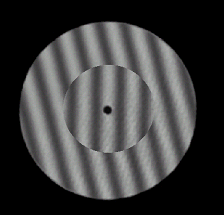
|
Differential Latencies and the Flash-Lag effect.
If a stationary object is flashed while physically aligned with a moving stimulus, the objects do not appear aligned. Instead, the moving stimulus appears to be spatially advanced relative to the apparent position of the flashed stimulus (Mackay, 1958; Mateeff & Hohnsbein, 1988; Nijhawan, 1994). For instance, consider a stimulus (see link below) in which there is a rotating grating surrounding an inner grey region. At one point during the rotation cycle, an inner grating is flashed. If the inner grating is flashed when it is physically aligned with the outer rotating grating - most observers will perceive the outer annulus as being slanted relative to the inner grating.
Click here to see the stimulus described above. (for best results - set movie to loop).
The Flash-Lag effect could readily be explained if the visual system was approximately 80ms slower to respond to flashed or stationary stimuli relative to persistent or moving stimuli. This could delay the perceptual experience of flashed or stationary stimuli.
Another phenomenon that can be elicited with a similar stimulus configuration is the tilt-illusion. If a central grating is surrounded by another grating of a different orientation, the central grating can look as if it is slanted away from the orientation of the outer grating. For instance, in the static image below you may feel that the central grating looks slanted toward the right, even though it is physically vertical. One interesting aspect of the tilt illision is that it must be mediated within the visual cortex of the brain - the first point within the visual system where neurons are found that are tuned to orientation.

Consideration of these facts suggested a way to test the differential latency explanation of the flash-lag effect. If the effect occurs because neural responses to flashed stimuli are relatively delayed, if we flash the the central grating 80ms before it becomes aligned with the outer rotating grating, no tilt-illusion should occur because by the time that it is processed by the visual system it will be aligned with the rotaing outer annulus.
When we flashed the inner grating ~80ms before the outer grating became aligned with it, our observers felt that the two gratings looked more or less aligned. This showed that we could measure the traditional Flash-Lag effect with this kind of stimulus. However, while the two gratings appaeared to be more or less aligned, the central grating still seemed to be slanted away from the physical orientation of the outer grating. This shows that the tilt illusion is determined by the phsycial relationship between the two gratings rather than by the perceptual relationsip.
Click here to see the stimulus described above. (for best results - set movie to loop).
These observations are problematic for a simple differential latency account of the Flash-Lag effect. If differential latency plays any role in generating the illusion the latency difference must arise after the point in the visual system at which the Tilt Illusion is generated.